Just as soon as it was clear that the Proton P2-30A (now the Iriz) was turning out to be a tall B-segment hatchback, comparisons to the Perodua Myvi were unavoidable. Then the prices were announced – with the Iriz coming within hundreds of the Myvi, spec-for-spec – and so a head-to-head battle becomes inevitable.
This was, of course, Proton coming into Perodua’s mainstay. The Myvi is only P2’s (and Malaysia’s) best-selling model for nine years straight after all, and here comes big brother Proton attempting to claim a slice of that big, undoubtedly hugely profitable pie. So, Proton Iriz vs Perodua Myvi – take your pick.
A disclaimer first, though: this is simply a pictorial piece, as we only had the Myvi for a short photography session. We’ve driven the Perodua before, of course, but we’re not about to write a whole comparison story based on driving impressions from a few years ago. We’ll do proper side-by-side evaluations soon enough, but for now, here’s a straight-up picture comparison.
On the outside, Proton’s latest is bigger than the Perodua on all accounts. At 3,905 mm long, 1,720 mm wide and 1,550 mm tall, the Iriz is 215 mm longer, 55 mm wider and 5 mm taller than the Myvi. It’s heavier too, naturally, at 1,185 kg versus the Myvi’s 980 kg. As pictured here, the Iriz 1.6 Premium wears 15-inch wheels over the Myvi 1.5 SE’s 14-inchers.
The top-spec Proton has LED daytime running lights while the Perodua has standard front foglamps (the Iriz 1.6 Executive has front fogs in place of the DRLs). Round the back, both have diffuser-like elements, though only the Myvi has an exposed exhaust pipe. For the record, Perodua offers two distinct sets of looks for the Myvi (standard and SE/Extreme), while Proton relies on a subtle bodykit to differentiate between Iriz variants.
Under the hoods, the Iriz has a 107 hp/150 Nm 1.6 litre VVT engine, versus the Myvi’s 102 hp/136 Nm 1.5 litre DVVT motor. The Proton, paired to a CVT ‘box, hits 100 km/h in a claimed 11.1 seconds, while the four-speed auto Myvi takes 12.5 seconds. In their manual transmission guises, however, the Myvi 1.5 does the deed in 10.0 seconds compared to the Iriz 1.6 MT’s 11.1 seconds (identical to the CVT).
Myvi’s MPV-style cabin frees up space with a dash-mounted gear lever; both have touch-screen head unitsFurther down the food chain, the Iriz 1.3 has 94 hp and 120 Nm of torque, compared to 90 hp and 117 Nm for the Myvi 1.3. The smaller-engined Iriz gets to 100 km/h in 12.2 seconds with a five-speed manual, and 13.1 seconds with a CVT. Perodua did not release any performance figures for the Myvi 1.3.
Inside, each takes a distinct approach to cabin design. The Iriz’s dashboard (above right) appears more modern, but conventional, while the Myvi has an MPV-like interior, with more emphasis put on cabin space. The dash-mounted gear lever on the Myvi makes for a more spacious front area, though the horizontally- rather than vertically-stacked air con controls in the Iriz appears more visually appealing.
In these forms, both have touch-screen head units, but only the Iriz has a reverse camera function. The Proton has auto headlamps and a full keyless entry system too (only in 1.6 Premium spec), while the Myvi counters with an Optitron-like electroluminescent instrument cluster over the Iriz’s conventional back-lit dials. Steering wheel audio controls are standard on the Iriz 1.6 and Myvi 1.5.
More rear legroom in the Myvi (left) but Iriz’s bench is more comfortable, and headrests are adjustableOn the safety front, the Iriz 1.6 Premium has six airbags (rest have two) and electronic stability control (ESC) as standard, while the Myvi SE has two airbags and no ESC. The electronic safety net is standard on all Iriz models, while the base Myvi XT loses on out ABS. The Proton received a five-star crash safety rating by ASEAN NCAP, while the Myvi was rated three stars.
Space wise, we have pictures of 175 cm-tall Jonathan James Tan sitting in both models. For both rear seat shots, we had the front seats adjusted to Jonathan’s ideal driving position for parity. It’s clear to see here that the Myvi (above left) has considerably more legroom in the back (headroom is about the same for both), but the Iriz has a more comfortable seating position and the convenience of adjustable rear headrests.
It’s a similar story when it comes to cargo space. Looking at volume alone, the Iriz wins at 215 litres versus the Myvi’s 208 litres, but that’s not the whole story. The Proton has a higher load sill, and its rear seats don’t fold flat to the floor compared to the Perodua. On the other hand, the Iriz has a better-designed parcel shelf that is far easier to take off and put on again (the Myvi’s is a tad too wide for easy operation).
So there you have it, a simple comparison between Malaysia’s two B-segment hatchbacks. What say you?
Proton Iriz
Perodua Myvi
AD: Drive the Proton model of your dreams. Submit your details and Proton PJ will get in touch with you.
Looking to sell your car? Sell it with Carro.

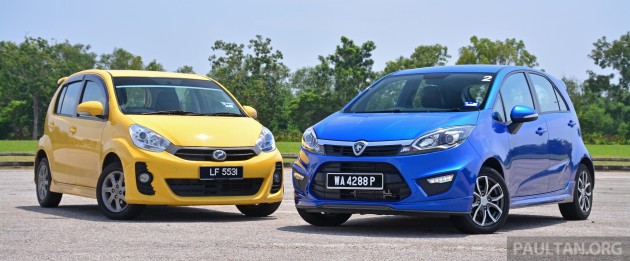







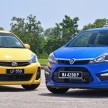

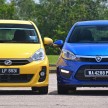

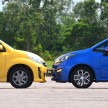
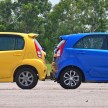
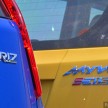
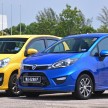
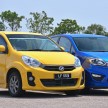

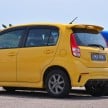
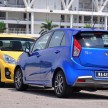
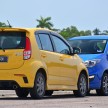
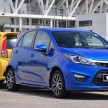
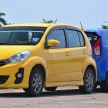
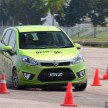
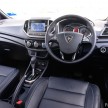
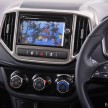
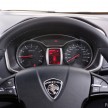
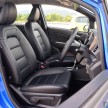
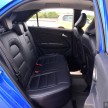


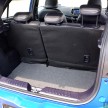
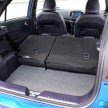
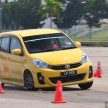
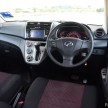

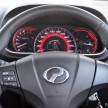
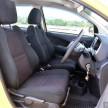
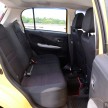


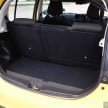
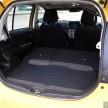
















AI-generated Summary ✨
Comments generally express positive sentiments about the Proton Iriz, highlighting its safety features, design, and size advantages over the Perodua Myvi, which is often criticized for outdated styling and basic features. Many appreciate the Iriz’s newer technology and European-inspired look, though some express reservations about Proton's overall reliability and aftersales service based on past experiences. There also exists a rivalry mindset where supporters discuss the technical and safety differences, such as airbags, crash ratings, and engine technology. While some still favor the proven reliability and low maintenance of the Myvi, especially in engine performance and resale value, the trend indicates increasing confidence and anticipation for Proton’s latest model to challenge the dominance of the Myvi in the Malaysian market. Overall, the comments reflect a mix of cautious optimism and national pride, with a focus on safety, value, and reforming perceptions.